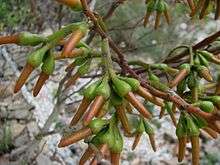Eucalyptus eremophila
| Eucalyptus eremophila | |
|---|---|
 | |
| flower buds | |
| Scientific classification | |
| Kingdom: | Plantae |
| (unranked): | Angiosperms |
| (unranked): | Eudicots |
| (unranked): | Rosids |
| Order: | Myrtales |
| Family: | Myrtaceae |
| Genus: | Eucalyptus |
| Species: | E. eremophila |
| Binomial name | |
| Eucalyptus eremophila (Diels) Maiden | |
| Synonyms | |
|
Eucalyptus occidentalis var. eremophila Diels | |
Eucalyptus eremophila is a eucalypt native to semi-arid regions of Western Australia. Common names include tall sand mallee, sand mallee, and Eastern Goldfields horned mallee.[1][2]
German botanist Ludwig Diels described the Eastern Goldfields horned mallee as a subspecies of Eucalyptus occidentalis in 1904, material comprising the type specimen collected in Coolgardie district by Ernst Georg Pritzel and Gilmore.[3] The epithet eremophila means "desert-loving". Joseph Maiden raised it to species status in 1921.[1]
Eucalyptus eremophila usually grows in a multi-stemmed mallee form, although single-stemmed individuals do occur. The bark is smooth and polished, shedding in late summer. The new bark is yellowish brown, maturing to just brown of gray. The fruit and flowers vary, but have a long tapering bud cap.
References
- 1 2 "Eucalyptus eremophila". Australian Plant Name Index (APNI), IBIS database. Centre for Plant Biodiversity Research, Australian Government, Canberra. Retrieved 5 January 2013.
- ↑ "Eucalyptus eremophila (Diels) Maiden". FloraBase. Western Australian Government Department of Parks and Wildlife.
- ↑ "Eucalyptus occidentalis var. eremophila Diels". Australian Plant Name Index (APNI), IBIS database. Centre for Plant Biodiversity Research, Australian Government, Canberra. Retrieved 10 January 2013.
- Holliday, I. A field guide to Australian trees (3rd edition), Reed New Holland, 2002
- Cronin, L. Key Guide to Australian Trees, Envirobook, 2000